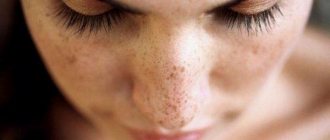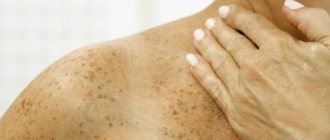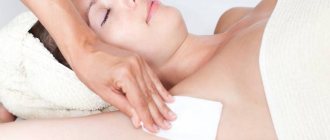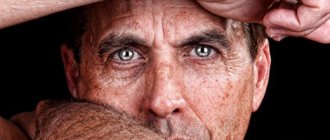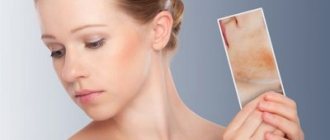Hyperpigmentation is becoming the most pressing issue in dermatology and cosmetology. Its manifestation is associated with excessive production of melanin, a coloring pigment formed in special cells - melanocytes. Excess melanin is not always a purely cosmetic problem, it can be pathological in nature, therefore, when a “spotty color” appears, the help of a qualified specialist is needed.
Causes of age spots on the body
Pigment spots on the body appear due to external factors or internal disorders. And if in the first case the defect can be eliminated with cosmetic procedures, then in the second it is necessary to identify internal pathologies and treat them, so hyperpigmentation should be taken seriously.
The reasons that cause excess production of the dark pigment melanin include:
- adolescence;
- regular use of oral contraceptives;
- consequences of pregnancy and childbirth due to hormonal changes;
- menopause;
- changes in the activity of the endocrine system;
- excessive exposure to direct sunlight or trips to the solarium;
- changes in metabolic processes;
- natural disorders during aging of the body;
- abnormal changes in the epidermis acquired congenitally;
- infections developing on the surface of the skin;
- unbalanced diet with a lack of a number of important components;
- pathologies of the liver and gall bladder;
- stress and constant nervous tension;
- allergic reactions to environmental substances, food, cosmetics, medications;
- consequences of skin rashes (pimples or acne).
There are many reasons, but the main one is exposure to UV rays on the skin, resulting in excess production of natural dye. The result can be an even and beautiful tan, but in some cases there is an uneven distribution of pigment, which appears on the skin in the form of spots of different shapes and shades.
Females experience severe discomfort due to uneven “coloring” of the skin. But if the defect is caused only by the rays of the sun or other external influences, then, with some effort, the problem can be solved using cosmetics and procedures.
Pathology progression
Melanin, which is found in the epidermis, is responsible for the appearance and growth of age spots. In some cases, its amount increases, causing the spots to increase in size.
Causes
Accurate identification of the cause of the growth of spots on the face will make it possible to stop this process, and even completely eliminate the formation. The main reasons for this condition include:
Exposure to ultraviolet radiation. A common cause of melanin activation in the deep layers of the skin. Therefore, if there are pigment spots on your face, it is not recommended to sunbathe without using sunscreen. This recommendation is relevant not only for summer. Winter sun can also cause age spots to grow. In this case, the formation may become inflamed.
- Poor quality cosmetics. If a person has a genetic predisposition to pigmentation, the use of low-quality cosmetics can cause spots to appear or increase in size.
- Metabolic disease. The formation can grow and become inflamed due to diseases of the gastrointestinal tract, disruption of the gallbladder and pancreas, deficiency of vitamins and minerals.
- Hormonal imbalance. One of the common reasons for the growth of formations. This can occur during pregnancy, taking oral contraceptives, thyroid disease, obesity, tumors of the pituitary gland and ovaries, as well as various pathologies of the adrenal glands.
Vitiligo. A skin disease in which not dark, but light spots form on the face. The reason for this is a lack of melanin in certain areas of the skin due to a malfunction of the endocrine system. At the same time, the size of the formations gradually increases. Melanin deficiency occurs in limited areas of the skin.
- Folic acid deficiency. Due to a lack of folic acid, new spots may appear, as well as existing ones may increase in size. The same condition can be caused by copper deficiency.
- Aging. A natural cause of growth in the size of age spots. In this case, those spots located on open areas of the skin increase in size.
- Stress. Nervous disorders are not the most common cause of growth of formations, but they are one of the reasons for the appearance of spots.
Possible complications
If a dark spot on the face becomes larger, it may indicate melanoma, a type of skin cancer. This cancer is one of the most aggressive types due to its rapid metastasis to organs and bones. Therefore, it is important to monitor pigmented areas of the skin in order to recognize the development of the disease in time.
Therefore, if the formation on the face is swollen or changes in size, you should urgently consult a doctor. You need to pay attention to the following changes:
asymmetry;
- heterogeneity;
- violation of the edges of the formation;
- increase in size;
- change in shape, color or the appearance of itching and pain.
Even if a change in the size of the spot is not caused by skin cancer, it may indicate serious diseases of the internal organs. Such diseases include:
- disorders of the pancreas;
- diseases of the spleen and intestines;
- inflammation of the ovaries;
- fungal skin diseases;
- lichen;
- hepatitis A.
Therefore, if the formation on the face becomes inflamed, you must immediately contact a specialist to prevent the occurrence of dangerous complications. In this case, you need to visit a gastroenterologist and dermatologist.
Specialists will prescribe a general blood test. In some cases, a biopsy of the formation will be required. It will be needed if the growth of pigmentation is suspected to be oncological.
To prevent such a serious complication of age spots as melanoma, it is necessary to regularly check existing formations. It is recommended to apply sunscreen to your face before leaving home. You should also visit a dermatologist at least once a year to detect cancer at an early stage.
Pigmented spots on the skin: symptoms and signs
The spots on the body are located randomly or have a specific localization in a specific place.
Based on their location, we can assume the reasons that caused the unwanted defect:
- Pigmentation on the face and chest indicates a hormonal imbalance, and in medicine the pathology is referred to as chloasma.
- Spots on the back of the hands or face in older people are classified as senile lentigo, the cause of which is the same ultraviolet radiation.
- Spots on different parts of the body appear in the younger generation, who like to take “sunbathing” for a long time. In this case, solar lentigo is formed.
- Harmless freckles, large in size or in the form of small spots, cover any part of the body, which causes a lot of trouble for their owners.
- Melanoma-type spots appear on closed areas of the skin: most often on the arms, legs and scalp. These are malignant neoplasms that disguise themselves as moles, colored by melanin.
- If dark areas appear around the mouth where melanin accumulates, then this is Brocca's meloderma - a rare disease that occurs against the background of frequent stress and nervous stress.
- Nevi or moles have a specific location on the body of their owners. They differ in color, shape and size, and can be convex or even. They are harmless, but sometimes develop into melanoma.
- Chaotically located spots that appear on the site of pimples or blackheads are post-acne. More often they form at a young age during the restructuring of the body and usually go away without any intervention. Sometimes you need to visit a beauty salon several times.
Thus, there are 5 main types of age spots: chloasma, lentigo, post-acne, freckles, nevi.
With skin diseases - neurodermatitis, lichen, eczema - the percentage of melanin increases or decreases. Secondary depigmentation occurs when, in addition to a serious disease, there is a problem with excess or insufficient pigment production.
Color due to melanin can have different shades. Light brown colors of different shapes indicate hormonal imbalance. More often they appear on the body of women during pregnancy and childbirth. In some cases, this shade indicates liver or gall bladder diseases.
Epheliras or freckles are usually pale brown or beige. The intensity of the color is related to the time of year: they are more brightly colored in spring and summer and look like small (large) ripples on the skin epidermis.
Pink or red spots are the result of allergic reactions caused by external irritants. Their presence may indicate the beginning of an inflammatory process or be a consequence of sunburn.
White spots or vitiligo are formed when the synthesis of melanin in melanocyte cells is impaired. Small white areas indicate a lack of vegetable dye, so we are talking about hypochromia.
Yellow spots in the form of plaque are not related to pigmentation. If they are located on the scalp, then this is a sign of seborrhea. Blue-black spots that look more like bruises are most often melanoma, hematoma, or caused by necrosis.
Types of age spots and their photos
Experts classify pigmented areas that appear on the body into several types.
Primary, these include:
- freckles;
- congenital or acquired spots from yellow to brown;
- senile.
Secondary - formed as a result of past diseases, especially infectious ones, or are a consequence of inflammatory processes on the skin.
Pigmentation is also classified by color:
- pink or light brown;
In 75% of cases they are formed under the influence of ultraviolet radiation.
- brown - signal hormonal imbalances or problems with the functioning of internal organs;
- red – occur after sunburn or are formed during inflammatory processes in the body;
- white – observed when there is a disturbance in the formation of melanin;
- yellow - can signal skin diseases;
- black - often a sign of skin pathology.
Important: only a doctor can correctly classify the spots on the body.
Methods for treating age spots on the skin
Basic products include medications, cosmetics and salon treatments. At the same time, they use folk recipes that help in the fight against hyperpigmentation.
Medications
For treatment, drugs are used that block or reduce the formation of melanin. They must contain one of the following acids: folic, ascorbic, azelaic, kojenic. They are the ones who eliminate “spotting”, evening out the skin tone and reducing the production of natural dye.
In practice, creams are most often used, the action of which is effective and the price is reasonable. Pigmentation problems are solved by cream Melanativ, Achromin, Clotrimazole, syntomycin emulsion, salicylic alcohol. The effect of the drugs is designed to last 4-8 weeks, and if during this time the defect has not disappeared, you need to seek help from a dermatologist.
Salon treatments
Hardware cosmetology allows you to rid a person of excessive hyperpigmentation on the body. But there are two pitfalls here: salon procedures are expensive pleasures and must be carried out by a doctor with the highest category and professional skills in this field.
Only a dermatologist who can determine the reasons for the improper distribution of melanin over the surface of the skin can recommend these methods. Salon procedures are designed to remove pigmentation in the middle and deep layers of the epidermis.
The following manipulations will help to even out the surface of the skin:
- Laser removal. During exposure, the laser is aimed at the pigment spot, destroys the structure of the pigment due to pulsed light energy, and the dark area is lightened. After laser therapy, the treatment site turns red and peels, and only after that the skin clears. This technique is characterized by: painlessness, minor trauma, action in a specific area, and a high percentage of getting rid of defects.
- Liquid nitrogen removal or cryotherapy are popular methods. Liquid nitrogen destroys surface cells, regeneration processes are enhanced, and the dermis layer is restored. For several weeks after the procedure, red spots are clearly visible at the treatment sites.
- Phototherapy is based on the action of infrared flashes that destroy melanocyte cells containing pigment. It is carried out without pain and does not injure the surface of the skin. The restoration of the epidermis occurs within a few days.
- Chemical peeling is carried out under the influence of chemicals that can lighten the surface of the dermis. For the procedure, salicylic and triacetic acids are most often used. Peeling has other positive aspects:
- restores the functions of the sebaceous glands;
- tightens pores;
- smooths out wrinkles;
- stops the further formation of spots and pimples.
Peeling can be superficial or deep. Superficial is not so traumatic, but its effect is not so effective. Deep acts longer because it eliminates the problem in different layers of the epidermis.
Superficial peeling is carried out as a home procedure and is available to everyone. In this case, a scrub with fruit acids is used. Regular use allows you to give the skin a uniform color.
Salon procedures are complex and are carried out in several steps. Skin care should also be taken between treatments. A cosmetologist should explain how to do this correctly.
Cosmetical tools
Cosmetics will help enhance the effect after hardware procedures. There are well-known cosmetic companies that produce a line of pigmented skin care products with a whitening effect. The most popular and recognized remedies by the fair sex include:
- creams: Badyaga, Boro plus, Klivrin, Biocon;
- masks: Vitex, Badyaga-forte, Grandmother Agafya’s recipes;
- serums: Ultra Brightening Serum, Blanc Expert MELANOLYSER, Idealia Pro from Vichy, White Linen.
All of these remedies are effective, and the choice is individual. The serum with the highest concentration of active substances has the fastest action. In addition, the ingredients penetrate into the deep layers of the dermis, which is “impossible” for most creams.
When buying a whitening product, pay attention to the composition. It should contain one of the above-mentioned acids or another equally effective component to even out skin tone. When using this line, avoid exposure to the sun.
Traditional medicine against age spots on the body
Folk remedies help get rid of “spotting” no worse than cosmetic preparations, since they contain exclusively natural ingredients that can minimize skin defects. The simplest and most common means:
- mask with kefir and cucumber;
- mask made of white clay and chamomile decoction;
- an extract made from bearberry, yarrow and licorice, added to a cream or body lotion;
- juices of lemon, parsley, cabbage or kefir (yogurt), which are used to wipe the face.
In the summer, juicy masks containing strawberries, red bell peppers and melon will help smooth out the skin texture. All components are mixed in a blender, a little kefir is added to the composition, and the mask is ready. Its use once a week in parallel with cosmetics guarantees “snow-white” skin.
The most effective folk remedies include the trio: parsley, white clay and lemon. Their use in home masks will help smooth out epidermal imperfections and even out skin tone.
As a result of melanosis
The most common cause of black spots on the surface of the skin is melanosis or melanopathy. Epithelial cells and mucous membranes produce large amounts of melanin. It is he who is responsible for skin tone. The main function of melanin is protective. It helps protect the skin from exposure to ultraviolet radiation.
Melanin production can be severely impaired by pathological factors. As a result of the production of large amounts of melanin, its excess will accumulate in certain parts of the body, leading to the appearance of dark spots of different shades.
READ ALSO: Treatment of wen with folk remedies at home
Prevention of the appearance of age spots on the body
The old truth says: it is better to prevent a disease than to treat it. This postulate applies to our problem. By following some simple recommendations, you can avoid the occurrence of unwanted skin defects:
- avoid being in direct sunlight for a long time;
- in summer, use creams with a high-level UV filter;
- wear a hat in the sun;
- stop going to the solarium;
- use good quality cosmetics from well-known and reliable brands;
- think over your diet, which must include vegetables and fruits.
The appearance of pigmentation, especially on the face, causes irritation and forces you to constantly be in tension, covering up and retouching dark spots. But not everything is so hopeless. The help of a qualified doctor, modern remedies and grandmother’s recipes will help you cope with the problem, and your skin will acquire an even and beautiful tone.
How to treat age spots?
Today, there are several ways to treat hyperpigmentation.
There are also folk remedies, but they not only do not provide a guaranteed result, but can also harm the skin.
The best and most reliable way is laser treatment or phototherapy. It's fast and efficient. In our laser cosmetology clinic “Laser Aesthetic”, to remove age spots, we use modern laser devices Candela and Lumenis IPL QUANTUM, which are recognized as the safest in the world! Call us or leave a request on the website to sign up for the procedure.
